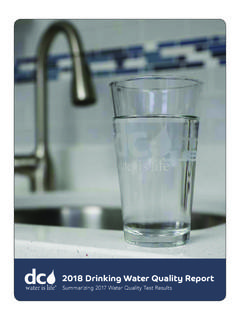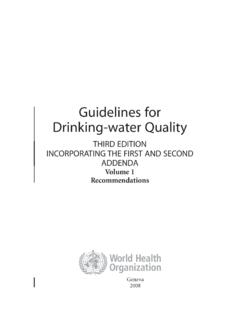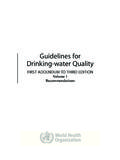Transcription of Saskatchewan s Drinking Water Quality Standards …
1 Explanation of TermsMaximum Acceptable Concentration (MAC)Interim Maximum Acceptable Concentration (IMAC) Aesthetic Objective (AO) Apparent Color Unit (ACU) Nephelometric Turbidity Unit (NTU)Milligrams per Litre (mg/L) Saskatchewan s Drinking WaterQuality Standards and Objectives (summarized)SaskatchewanEnvironmentStand ards are legally enforceable requirements for Drinking Water Quality and are set out in The Water Regulations, 2002. Bacteriological Standards : Effective immediately, Standards include:!total coliform levels of zero organisms detectable per 100 millilitre (mL);!fecal coliform levels of zero organisms detectable per 100 mL; and!background bacteria levels on a total coliform or a fecal coliform membrane filtration plate of less than 200 colonies per 100 mL or no Standards : Turbidity is an important indicator of Water treatment process efficiency from both health and aesthetic perspectives.
2 Compliance with turbidity Standards is immediate for newly constructed waterworks. Existing waterworks producing Water for human consumptive use will be required to meet the Standards by December 5, 2008 for systems serving a population of less than 5,000 and by December 5, 2006 for systems serving a population of 5,000 or Includes surface waters and groundwater under the influence of surface Water . Turbidity value measured from each filter effluent. Turbidity value for Water entering the distribution system. 4 Measurements made in each calendar month. Other requirements apply for novel surface Water treatment technologies. Source/Treatment1,2 Surface Water : Chemically Assisted Filtration - When monthly source Water average is NTU or more1,2 Surface Water : Chemically Assisted Filtration - When monthly source Water average is less than NTU1,2 Surface Water : Membrane Filtration1,2 Surface Water .
3 Slow Sand or Diatomaceous Earth Filtration3 GroundwaterRoutine StandardLess than NTU, 95% of discrete 4measurements or 95% time if continuous monitoring employedLess than NTU, 95% of discrete 4measurements or 95% time if continuous monitoring employedLess than NTU, 95% of discrete 4measurements or 95% time if continuous monitoring employedLess than NTU, 95% of discrete 4measurements or 95% time if continuous monitoring employedLess than NTU, 95% of discrete 4measurements or 95% time if continuous monitoring employedContinuous Monitoring Time Duration MaximumNot to exceed NTU for more than 12 consecutive hours if continuous monitoring employedNot to exceed NTU for more than 12 consecutive hours if continuous monitoring employedNo stated standardNot to exceed NTU for more than 12 consecutive hours if continuous monitoring employedNo stated standardAbsolute MaximumNever to exceed NTUN ever to exceed NTUN ever to exceed NTUN ever to exceed NTUNo stated standard - see permitObjectives apply to certain characteristics of, or substances found in Water for human consumptive or hygienic use.
4 The presence of these substances will affect the acceptance of Water by consumers and/or interfere with the practice of supplying good Quality Water . Compliance with Drinking Water objectives is not mandatory as these objectives are in the range where they do not constitute a health hazard. However, these substances may represent a health risk to some people if found in excessive concentrations. The Aesthetic Objectives for several parameters (including hardness as CaCO, magnesium, sodium and total 3dissolved solids) consider regional differences in Drinking Water PhysicalParameterAOColor15 to <15 CTotal Dissolved Solids (TDS): For the purposes of Saskatchewan Environment's Drinking Water Quality objectives, TDS are based on summation of ions. Summation of Ions: Cl + SO+ Ca + Mg + K + Na + NO + CO + 433 HCO = TDS calculation3 EPB207 / 2006 ChemicalParameterAO (mg/L)1 Sodium: It is recommended sodium be included in routine monitoring programmes.
5 Sodium levels may be of interest to authorities who wish to prescribe sodium-restricted diets to their : There may be a laxative effect in some individuals when sulphate levels exceed 500 Pesticides (commonly used in Saskatchewan )ParameterMACIMAC(mg/L)(mg/L ) , - Health CategoryParameterMACIMAC(mg/L)(mg/L) (a) , 1, , 1, , 1,2 , 1, , 2, 3 Nitrate as , 2,3,4, , 2,4, (THM) Maximum allowable concentration of naturally occurring fluoride in a treated Drinking Water intended or used for human consumptive Faucets should be thoroughly flushed before sample is Nitrate levels in excess of 45 mg/L (10 mg/L as nitrate-nitrogen) may cause adverse health effects in infants less than six months old. Where nitrate and nitrite are determined separately, levels of nitrite should not exceed Based on an annual average of 4 seasonal 2,4 Dichlorophenoxyacetic acid 6 Water samples may be initially screened for radioactivity using gross alpha and gross beta activity determinations.
6 Compliance with the Standards may be inferred if the measurements for gross alpha and gross beta activity are less than Bq/L and 1 Bq/L, respectively, as these are lower than the strictest MACs. If these values are exceeded then Part 5 of the Guidelines for Canadian Drinking Water Quality , Sixth Edition, Health Canada, 1996, as amended from time to time, RadiologicalScreening Concentration BecquerelsParameterPer litre (Bq/L)Gross Standards and objectives can be applied to Water for both hygienic use and human consumption. In general, Standards are mandatory for systems that supply Water for human consumptive use. For systems that supply Water for hygienic use, only bacteriological Standards apply. Both systems should also strive to achieve the Water Quality Health/Pesticides/RadiologicalThese include a range of substances that are known or suspected to cause adverse effects on health.
7 These values have been derived to safeguard health on the basis of life long consumption. Compliance with chemical Standards is immediate for newly constructed waterworks. Existing waterworks producing Water for human consumptive use will be required to meet the Standards by December 5, 2010 for systems serving a population of less than 5,000 and by December 5, 2008 for systems serving a population of 5,000 or (as CaCO)5003 Chloride250 Copper1 Ethylbenzene (as CaCO) (as HS) Total Dissolved





